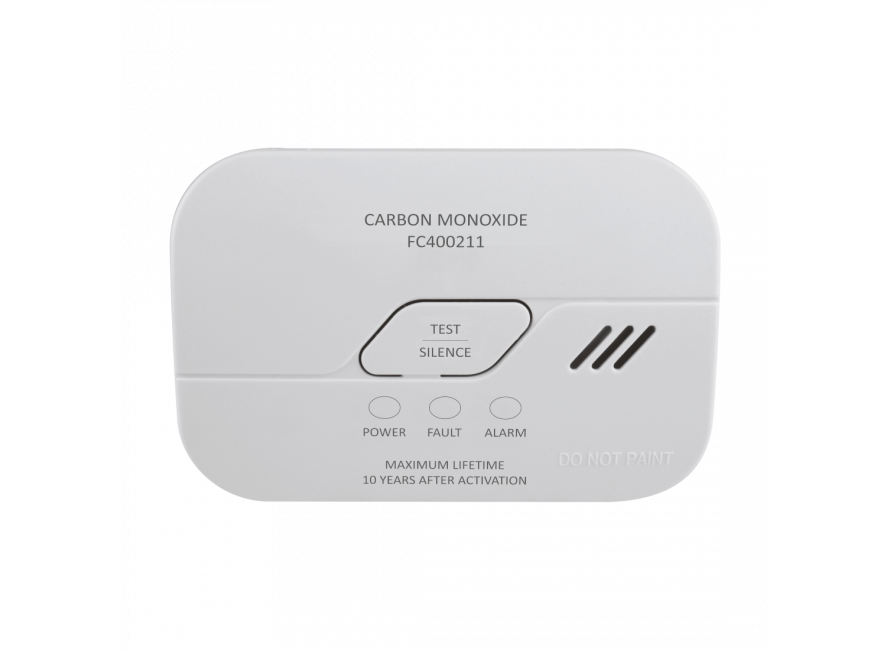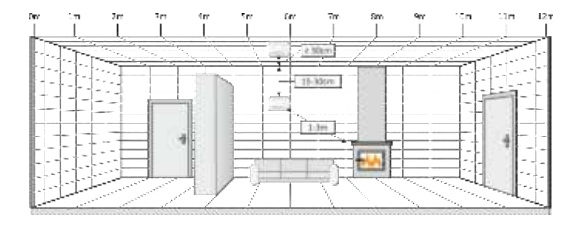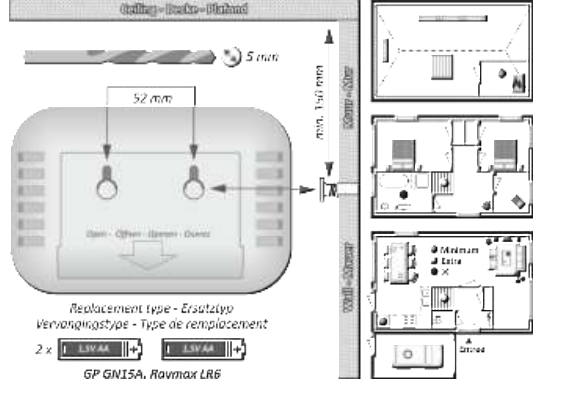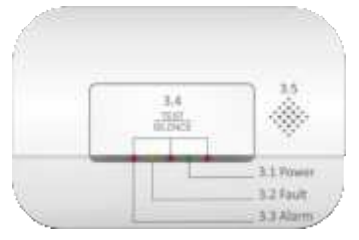ELRO FC270211 CARBON MONOXIDE DETECTOR
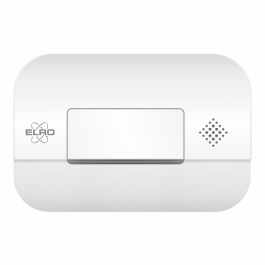
We are constantly improving our products and service. Go to www.elro.eu to download the latest version of this manual! Also check www.elro.eu for all relevant frequently asked questions and newest developments for this product. This will help you to better understand the product.
GeneralThank you for purchasing the FC270211 carbon monoxide (CO) alarm. This device is a product that has been built using state-of-the-art technology. This user guide contains important information on starting operation and using the devise. Store this user guide in a safe place for future reference. These instructions are a part of this product bear this in mind if you pass on this product to others. Please take a few minutes to thoroughly read the user’s guide and familiarize yourself and your family with its operation.CAUTION:
- This CO alarm is designed for indoor use only.
- DO not expose to rain or moisture.
- DO not knock or drop the detector.
- DO not open or tamper with the alarm as this could cause malfunction.The alarm will not protect against the risk of carbon monoxide poisoning when the battery has drained. Installation of the alarm should not be used as a substitute for proper installation, use and maintenance of fuel burning appliances including appropriate ventilation and exhaust systems.
Installation instructions
Installation location
- In rooms containing a combustion appliance, you can install the carbon monoxide detector in the following location:
- At a horizontal distance of 1-3 meters from the combustion appliance.
- If the space is divided by a wall or, for example, a large cupboard: on the same side as the combustion appliance
- Preferably on the ceiling:
- At a minimal distance of 30 cm from the wall.
- In the centre of the room.
- If ceiling mounting is not possible, the device can be mounted on the wall:
- Approximately 15-30 centimeters from the ceiling
- Above the top of windows/doors near the combustion appliance.
- In rooms without a combustion appliance, install the carbon monoxide detector on the wall at breathing height. The breathing height depends on the type of room: in a bedroom, you consider the breathing height from a sleeping position; in an office, you consider the breathing height in a sitting position; and in a corridor, you consider the breathing height in a walking position.CAUTION:
- This alarm should be installed by a competent person.

Mounting step
- Drill two 5.0 mm holes in the wall, the distance between two holes center is 52mm, then insert two plastic stopper (provided) into the holes.
- Insert the two screws (provided) until the screw heads are approximately 5mm from wall.
- Test the unit by using the TEST/SILENCE button. Ensure the unit sound is alarm pattern.
- Hook the unit over the screws onto keyholes in back of unit.

Recommended installation locationsThe following suggestions are intended to help you with the placement and installation of your CO alarm.
- Place out of the reach of children. Under no circumstance should children be allowed to handle the CO alarm.
- Install in a bedroom or hallway located close to the sleeping area. Take special care to verify the alarm can be heard in sleeping areas.
- It is recommended that a CO alarm be installed on each level of a multilevel home.
- Locate 1 – 3 meter (3.3 – 10 feet) away from all fuel burning appliances.
- Insure that all vents of the unit are unobstructed.
- Do not install in dead air spaces such as peaks of vaulted ceilings, or gabled roofs.
- Do not install in turbulent air from ceiling fans.
- Do not place near fresh air vents or close to doors and windows that open to the outside.
- Keep the CO alarm away from excessively dusty, dirty, or greasy areas such as kitchens, garages and furnace rooms. Dust, grease and household chemicals can affect the sensor.
- Keep out of damp and humid areas such as the bath room. Avoid spraying aerosols near the CO alarm.
- Do not install in areas where the temperature is below -10°C or hotter than 40°C.
- Do not place behind curtains or furniture. CO must be able to reach the sensor for the unit to accurately detect CO.
Product overview
POWER indicatorThe POWER indicator (green LED) is used to indicate power status of the CO alarm. The POWER indicator will flash every 40 seconds.FAULT indicatorThe FAULT indicator (yellow LED) is used to indicate fault or warning status of the CO alarm.ALARM indicatorThe ALARM indicator (3 x red LED) is used to indicate alarm status of the CO alarm.TEST/SILENCE buttonThe TEST/SILENCE button is used to test the unit. Press and hold to enable TEST function. When the alarm making a CO alarm warning or other warning sound, you can push this button to make the device silence.Alarm sounderThe alarm sounder is used to send out CO alarm warning, fault warning information etc.
Understanding your CO alarm
Start upAfter connecting the battery, all three LEDs light up briefly and the CO alarm confirms startup with a beep. After power on, the green LED flashes once per second within 60 seconds, this is preheated state, 60 seconds later the green LED flashing every 40 seconds indicates the unit is functioning properly.Normal operationThe POWER indicator (green LED) flashing every 40 seconds.Fault warningIf the unit beeps twice every 8 seconds and the FAULT indicator (yellow LED) flashes. It indicates the CO alarm is in malfunction condition. That means your CO alarm has no detecting function and will not respond to CO. Please contact us immediately for more services.Fault warning silenceWhen the alarm is under the fault warning, press the TEST/SILENCE button, it will come into silence status for about 9 hours, while the FAULT indicator (yellow LED) keeps on flashing.Low battery voltage warningIf the alarm beeps once every 40 seconds, with FAULT indictor (yellow LED) will be flash. It indicates the battery is low.NOTE:
- You need to replace the batteries immediately when the alarm enters this status.
- The alarm will not protect against the risk of carbon monoxide poisoning when the battery is empty.
- Refer to “5. Battery installation/replacement” when you hear the sound of a low battery voltage warning.
Low battery voltage warning silenceWhen the alarm is under the low battery warning, pressing the TEST/SILENCE button, it will come into silence status for about 9 hours, and FAULT indicator (yellow LED) will keep on flashing.NOTE: When alarm under the low battery warning, please replace the battery in time to ensure a normal operation.End of life warningIf the alarm beeps 3 times every 40 seconds with FAULT indicator (yellow LED) flash. It indicates end of life of the CO alarm. You need to immediately replace the CO alarm.End of life warning silenceWhen the alarm is under the end of life warning, pressing the TEST/SILENCE button, it will come into silence status for about 9 hours, and FAULT indicator (yellow LED) still keep flashing.CO alarm warningWhen the alarm detects a dangerous level of CO, the alarm will emit a loud alarm pattern. The alarm signal pattern is 4 quick beeps followed by 5 seconds of silence. This cyclerepeats as long as a dangerous CO condition exists. The red alarm LED will flash the same pattern. This signal will repeated until the alarm resets after dissipation of CO. Sensitivity Setting: Conforms to EN 50291-1:2018 standard.030PPM – Without alarm before 120 minutes050PPM – Between 60 to 90 minutes100PPM – Between 10 to 40 minutes300PPM – Less than 3 minutesNOTE: Refer to “4. What to do if the alarm sounds” when you hear the sounds of the CO alarm warning.CO alarm warning silenceDuring the device under CO alarm mode, press the TEST/SILENCE button, it will pause the alarm sound of the device for 10 minutes. The ALARM indictor (red) will keep flash as CO alarm mode, it indicates the device is running into the CO alarm silence mode.NOTE: The audible alarm signal will reactivate about 10 minutes from the time the TEST/SILENCE button is operated where the concentration of CO surrounding the alarm remains at 50 PPM or higher.NOTE: The audible alarm signal cannot be silenced if the alarm exceeds concentrations above 200 PPM.NOTE: The alarm silencing activation can only be used once throughout a CO alarm period.WARNING: Before using the silence activation, you must understand the alarm is due to dangerous levels of carbon monoxide and the dwelling should be evacuated.
Adjusted alarm volume: If the alarm comes into the status of CO alarm warning, the alarm will start in a lower alarm volume (<85dB) for the first 8 sounds, then it will issue a normal alarm volume (>85dB). It will avoid people to be scared suddenly by a loud alarm sound.Test the unit: To test the alarm, press and hold TEST/SILENCE button, you should hear alarm sound patterns with a corresponding ALARM indicator (red LED) flash. The alarm sound patterns will stop when release TEST/SILENCE button. The test alarm sound pattern includes: 4 short beeps, 5 seconds pause, repeat the pattern until release TEST/SILENCE button.
TIP! If you want to hear the loud alarm, continuously push the test button, from the 9th beep onwards the volume will increase to the real (loud) alarm volume.NOTE: After the TEST/SILENCE button is enabled, the alarm sounds and the red alarm light flashes. This does not indicate that CO is present.NOTE: Test the unit weekly! If at any time your unit does not perform as described, replace it immediately.
What to do if the alarm soundsWARNING! Actuation of your CO alarm indicates the presence of Carbon Monoxide (CO) which can KILL YOU.WARNING! Action of this device indicates the presence of dangerous levels of CO! CO can be fatal!
If the alarm sounds:
- Operate the TEST/SILENCE button.
- Shut down furnaces and gas supply.
- Immediately move to fresh air outdoor or by an open door/window. Do a number of people count to check that all persons are inventoried. Do not reenter the premises nor move away from the open door/window until the emergency services responders have arrived, the premises have been aired out, and your alarm remains in its normal condition.
- After following steps 1-3 , if your alarm reactivates within a 24 hour period, repeat steps 1-3 and call a qualified appliance technician to investigate for sources of CO from fuel burning equipment and appliances and inspect for proper operation of this equipment, if problems are identified during this inspection, have the equipment serviced immediately. Note any combustion equipment not inspected by the technician and consult the manufacturer’s instructions or contact the manufacturer directly for more information about CO safety and this equipment. Make sure that motor vehicles are not or have not been operating in an attached garage or adjacent to the residence.
| Mode | Light signal | Audio signal | Explanation |
| Standby | Green flashes 1 x per 40 sec. | No sound | Detector functions correctly |
| Test | Red flashes 4 x quickly, followed by 5 sec. short break | 4 x quickly, followed by 5 sec. break | Detector functions correctly |
| CO alarm | Red flashes 4 x quickly, followed by 5 sec. break | 4 x quickly, followed by 5 sec. break | Detector has detected carbon monoxide |
| CO alarm mute | Red flashes 1x per 40 sec. followed by 5 sec. break | No sound | Alarm signal is muted |
| Low battery voltage | Yellow flashes 1 x per 40 sec. | 1 x per 40 sec. | Low battery voltage, replace batteries asap |
| Low battery mute | Yellow flashes 1 x per 40 sec. | No sound | Low battery warning muted for approx. 9 h. |
| Malfunction error | Yellow flashes 2 x per 8 sec. | 2 x per 8 sec. | Malfunction detected, replace device asap |
| End of life | Yellow flashes 3 x per 40 sec. | 3 x per 8 sec. | End of life, replace device asap |
Battery installation/replacement
Two beeps with corresponding FAULT indicator (yellow LED) flashing twice every 40 seconds indicates that the battery level is low, you must replace with the battery specified, please see “8. Specifications“ To install or replace the battery in unit, please perform the following steps:
- Take down the unit from screw heads of the wall.
- Open battery compartment.
- Remove the old battery and replace by new battery.
- Check the alarm, the green LED should flash once a second in the first 60 seconds, if not, remove the battery and put them in again.
- Close battery compartment.
- Hook the alarm body over the screw heads onto keyholes in back of the unit.
- Test alarm using the TEST/SILENCE button, if the testing alarm is ok, means the product can work normally.
WARNING! Use only the battery specified. Use of different battery may have a detrimental effect on the CO alarm. A good safety measure is to replace the battery at least once a year.NOTE: Reinstall immediately after cleaning and then test unit using the TEST/SILENCE button!
General maintenance
To keep your CO alarm in good working order, please follow these simple steps:
- Verify the unit’s alarm sound and indictors operation by enable the TEST/SILENCE button once a week.
- Remove the unit from the wall and clean the alarm cover and vents with a soft brush attachment once a month to remove dust and dirt.
- Avoid spraying air fresheners, hair spray, or other aerosols near the CO alarm.
- Do not paint the unit. Paint will seal the vents and interfere with the sensor’s ability to detect CO. Never attempt to disassemble the unit or clean inside. This action will void your warranty.
- As soon as possible, place the CO alarm back in its proper location to assure continuous protection from carbon monoxide poisoning.
- When household cleaning supplies or similar contaminants are used, the area should be ventilated.WARNING! The following substances can affect the sensor and may cause false actions: methane, propane, isobutene, isopropanol, ethylene, benzene, toluene, ethyl acetate, hydrogen sulfide, sulfur dioxides, alcohol based products, paints, thinner, solvents, adhesives, hair sprays, after shaves ,perfumes and some cleaning agents.WARNING! Your CO alarm will not be operational and will not monitor for CO levels without battery.WARNING! This apparatus is designed to protect individuals from the acute effects of carbon monoxide exposure. It will not fully safeguard individuals with specific medical conditions. If in doubt consult a medical practitioner.
Carbon monoxide (CO) overviewCO cannot be seen, smelled or tasted and can be fatal. The build up of CO in the blood is called the carboxyhemoglobin (COHb) level and interferes with the body’s ability to supply itself with oxygen. Depending on the concentration, CO can kill in minutes. The most common sources of CO are malfunctioning gas appliance used for heating and cooking, vehicles running in an attached garage, blocked chimneys or flues, portable fuel burning heaters, fireplaces, fuel powered tools and operating a grill in an enclosed space. Indications of carbon monoxide poisoning include symptoms similar to the flu, but with no fever. Other symptoms include dizziness, fatigue, weakness, headache, nausea, vomiting, sleepiness and confusion. Every year a qualified technician should inspect and clean your heating system, vents, chimney, and flues. The following symptoms are related to CARBON MONOXIDE POISONING and should be discussed with ALL members of the household:
- Mild Exposure: Slight headache, nausea, vomiting, fatigue (often described as “Flu-like” symptoms).
- Medium Exposure: Severe throbbing headache, drowsiness, fast heat rate.
- Extreme Exposure: Unconsciousness, cardiorespiratory failure, death. The above levels of exposure relate to healthy adults. Levels differ for those at high risk. Exposure to high levels of carbon monoxide can be fatal or cause permanent damage and disabilities. Many cases of reported carbon monoxide poisoning indicate that while victims are aware they are not well, they become so disoriented they are unable to save themselves by either exiting the building, or calling for assistance. Also, young children and household pets may be the first effected. Familiarization with the effects of each level is important.WARNING! Exposure to high levels of carbon monoxide can be fatal or cause permanent damage and disabilities.
Service and contact
Would you like to contact us? That is possible! To ensure that we can serve our customers as well and quickly as possible, we kindly ask you to take the following into account:For questions about the installation, use or operation of this product:
- Go to www.elro.eu to quickly get an answer to your question. Here you will find answers to frequently asked questions, detailed installation videos and the most recent version of the manual for your product.
- Cannot find a solution on the website? Then leave a question via the product page. We will help you as soon as possible.
Specifications
Model : FC270211Type of apparatus : Type BPower Supply : DC 3V (2pcs alkaline battery)Recommend battery type : GP GN15A / Raymax LR6 (For 3 years battery life at normal operation)Sensor Type : ElectrochemicalProduct Life : 10 years after manufactureSensitivity Setting : Conforms to EN 50291-1:2018 standard. 030PPM Without alarm before 120 minutes 050PPM Between 60 to 90 minutes 100PPM Between 10 to 40 minutes 300PPM Less than 3 minutesStandby Current : <20μA (average)Alarm Current : <30mA (average)Operation Ambient Condition : -10~+40℃, 30~95% non-condensingStorage/Transport Ambient Condition : -20~+50℃, 10~95% non-condensingAlarm Sound : ≥85DB at 3m @3.2±0.5KHz pulsing alarmCO Alarm Silence : About 10 minutesOther Warning Silence : About 9 hoursInstallation Location : Ceiling or wall of domestic premisesDetection Range : Max. 40 m2 within a room
NOTE: This CO alarm is designed to detect carbon monoxide gas from any source of combustion. It is not designed to detect any other gas.
SymbolsRecycling and Disposal: The WEEE symbol indicates that this product and its batteries must be disposed of separately from household waste. When this product reaches the end of its service life, take it to a designated waste collection point nearby to ensure safe disposal or recycling. Protect the environment and human health, use natural resources responsibly! Updates or new warmings might apply to the manual. Always check the most up to datemanual on www.elro.eu before installing or reinstalling the product. Read the manual before use and keep it in a safe place for future use and maintenance.Guarantee visit www.elro.euELRO Europe | www.elro.euPostbus 9607 – Box E8001006 GC Amsterdam – The Netherlands
References
[xyz-ips snippet=”download-snippet”]

